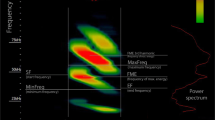Abstract
Unlike any other foraging phyllostomid bat studied to date, Poey’s flower bats (Phyllonycteris poeyi-Phyllostomidae) emit relatively long (up to 7.2 ms), intense, single-harmonic echolocation calls. These calls are readily detectable at distances of at least 15 m. Furthermore, the echolocation calls contain only the first harmonic, which is usually filtered out in the vocal tract of phyllostomids. The foraging echolocation calls of P. poeyi are more like search-phase echolocation calls of sympatric aerial-feeding bats (Molossidae, Vespertilionidae, Mormoopidae). Intense, long, narrowband, single-harmonic echolocation calls focus acoustic energy maximizing range and favoring detection, which may be particularly important for cruising bats, like P. poeyi, when flying in the open. Flying in enclosed spaces, P. poeyi emit short, low-intensity, frequency-modulated, multiharmonic echolocation calls typical of other phyllostomids. This is the first report of a phyllostomid species emitting long, intense, single-harmonic echolocation calls with most energy in the first harmonic.


Similar content being viewed by others
References
Barclay RMR, Fenton MB, Tuttle MD, Ryan MJ (1981) Echolocation calls produced by Trachops chirrosus (Chiroptera: Phyllostomidae) when hunting for frogs. Can J Zool 59:750–753
Belwood JJ (1988) Foraging behavior, prey selection and echolocation in phyllostomine bats (Phyllostomidae). In: Nachtigall PE (ed) Animal sonar system, vol 156. Plenum, New York, pp 601–605
Fenton MB (1995) Natural history and biosonar signals. In: Fay RR, Popper AN (eds) Hearing by bats. Springer Handbook of auditory research. Springer, Berlin Heidelberg New York, pp 17–86
Findley JS (1993) Bats: a community perspective. University Press, Cambridge
Griffin DR (1958) Listening in the dark. Yale University Press, New Haven, pp 229–251
Holderied MW, von Helversen O (2003) Echolocation range and wingbeat period match in aerial-hawking bats. Proc R Soc Lond B 270:2293–2299
Howell DJ (1974) Acoustic behavior and feeding in glossophagines bats. J Mammal 55:293–308
Jenning NVS, Parsons S, Barlow KE, Gannon MR (2004) Echolocation calls and wing morphology of bats from the West Indies. Acta Chiropterologica 6:75–90
Jensen ME, Miller LA (1999) Echolocation signals of the bat Eptesicus serotinus recorded using a vertical array: effect of flight altitude on searching signals. Behav Ecol Sociobiol 47:60–69
Jones G, Teeling EC (2006) The evolution of echolocation in bats. Trends Ecol Evol 21(3):149–156
Kalko EKV (2004) Neotropical leaf-nosed bats (Phyllostomidae): “whispering” bats or candidates for acoustic surveys? In: Brigham M, Kalko EKV, Jones G, Parsons S, Limpens HJGA (eds) Bat echolocation research: tools, techniques and analysis. Bat Conservation International, Austin, pp 63–69
Kalko EKV, Condon MA (1998) Echolocation, olfaction and fruit display: how bats find fruit of flagellichorous cucurbits. Funct Ecol 12:364–372
Koopman KF (1993) Order Chiroptera. In: Wilson DE, Reeder DM (eds) Mammal species of the world, a taxonomic and geographic reference. Smithsonian Institution Press, Washington, DC, 2nd edn, pp 137–241
Korine C, Kalko EKV (2005) Fruit detection and discrimination by small fruit-eating bats (Phyllostomidae): echolocation call design and olfaction. Behav Ecol Sociobiol 59:12–23
Macías S, Mora EC, Koch C, von Helversen O (2005) Echolocation behaviour of Phyllops falcatus (Chiroptera: Phyllostomidae): unusual frequency range of the first harmonic. Acta Chiropterologica 7(2):275–283
Novick A (1963) Orientation in neotropical bats. II. Phyllostomidae and Desmodontidae. J Mammal 44:44–57
Schnitzler HU, Kalko EKV (1998) How echolocating bats search and find food. In: Kunz TH, Racey PA (eds) Bat biology and conservation. Smithsonian Institution Press, London, pp 183–204
Schnitzler HU, Kalko EKV (2001) Echolocation behavior at insect-eating bats. Bioscience, 51:557–569
Silva G (1979) Los murciélagos de Cuba. Editorial Academia, La Habana
Simmons JA, Stein RA (1980) Acoustic imaging in bat sonar: echolocation signals and the evolution of echolocation. J Comp Physiol A 135:61–84
Thies W, Kalko EKV, Schnitzler HU (1998) The roles of echolocation and olfaction in two neotropical fruit-eating bats, Carollia perspicillata and C. castanea, feeding on Piper. Behav Ecol Sociobiol 42:397–409
Acknowledgements
The authors want to express their gratitude to Luis Manuel Díaz and Antonio Cadiz who helped in localizing the foraging bats and during the recording sessions. This study was supported by the Alexander von Humboldt foundation, Germany, to ECM. We also thank Dr. Brock Fenton for his support and three other anonymous referees for their valuable comments on earlier versions of the manuscript.
Author information
Authors and Affiliations
Corresponding author
Rights and permissions
About this article
Cite this article
Mora, E.C., Macías, S. Echolocation calls of Poey’s flower bat (Phyllonycteris poeyi) unlike those of other phyllostomids. Naturwissenschaften 94, 380–383 (2007). https://doi.org/10.1007/s00114-006-0198-7
Received:
Revised:
Accepted:
Published:
Issue Date:
DOI: https://doi.org/10.1007/s00114-006-0198-7




